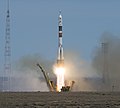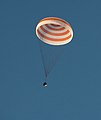Sojus MS-04
| Missionsdaten | |||
|---|---|---|---|
| Mission | Sojus MS-04 | ||
| NSSDCA ID | 2017-020A | ||
| Raumfahrzeug | Sojus 7K-MS (GRAU-Index 11F732) Seriennummer 735[1] | ||
| Rufzeichen | Олимп („Olymp“) | ||
| Trägerrakete | Sojus FG (GRAU-Index 11A511FG) | ||
| Besatzung | 2 / 3 | ||
| Start | 20. April 2017, 07:13 UTC | ||
| Startplatz | Baikonur 1/5 | ||
| Raumstation | ISS | ||
| Andockplatz | Poisk | ||
| Ankopplung | 20. April 2017, 13:18 UTC | ||
| Abkopplung | 2. September 2017, 21:58 UTC | ||
| Dauer auf ISS | 135d 08h 40min | ||
| Landung | 3. September 2017, 01:21 UTC | ||
| Landeplatz | 147 km SÖ von Schesqasghan, Kasachstan | ||
| Flugdauer | 135d 18h 08min | ||
| Erdumkreisungen | 2136 | ||
| Mannschaftsfoto | |||
 Fjodor Jurtschichin und Jack Fischer | |||
| ◄ Vorher / nachher ► | |||
| |||
Sojus MS-04 war eine Missionsbezeichnung für einen Flug des russischen Raumschiffs Sojus zur Internationalen Raumstation. Im Rahmen des ISS-Programms trug der Flug die Bezeichnung ISS AF-50S. Es war der 50. Besuch eines Sojus-Raumschiffs an der ISS und der 156. Flug im Sojusprogramm.
Besatzung
Startbesatzung
- Fjodor Nikolajewitsch Jurtschichin (5. Raumflug), Kommandant (Russland/Roskosmos)
- Jack Fischer (1. Raumflug), Bordingenieur (USA/NASA)
Ersatzmannschaft
- Sergei Nikolajewitsch Rjasanski (2. Raumflug), Kommandant (Russland/Roskosmos)
- Randolph Bresnik (2. Raumflug), Bordingenieur (USA/NASA)
Rückkehrbesatzung
- Fjodor Nikolajewitsch Jurtschichin (5. Raumflug), Kommandant (Russland/Roskosmos)
- Jack Fischer (1. Raumflug), Bordingenieur (USA/NASA)
- Peggy Whitson (3. Raumflug), Bordingenieurin (USA/NASA)
Peggy Whitson kam mit Sojus MS-03 zur ISS. Durch den freien Platz an Bord von Sojus MS-04 konnte ihr Aufenthalt um drei Monate verlängert werden.[2]
Missionsbeschreibung
Die Mission brachte zwei Besatzungsmitglieder der ISS-Expeditionen 51 und 52 zur Internationalen Raumstation. Ursprünglich sollte diese Crew mit Sojus MS-05 fliegen. Allerdings entschied Roskosmos, die Mission der Crew mit Ausnahme Paolo Nespolis vorzuverlegen, um so Einsparungen im ISS-Betrieb zu erreichen.[3]
Ursprünglich sollte die Mission mit dem Raumschiff 734 durchgeführt werden. Am 16. Januar 2017 wurde jedoch bekannt gegeben, dass stattdessen das Raumschiff 735 verwendet würde. Dies hätte keine technischen, sondern vertragliche Gründe.[1]
Sojus MS-04 koppelte planmäßig im „Expressmodus“, d. h. nach vier Erdumläufen am russischen ISS-Modul Poisk an.
Das Abdocken erfolgte am 2. September 2017 um 21:58 UTC, damit begann auf der Station die ISS-Expedition 53 mit Randolph Bresnik als Kommandant. Die Landung erfolgte einen Tag später um 01:21 UTC 148 km südöstlich von Scheskasgan in der kasachischen Steppe.
Galerie
Siehe auch
- Liste der bemannten Missionen zur Internationalen Raumstation
- Liste der bemannten Raumflüge
- Liste der Sojus-Missionen
Weblinks
- Sojus MS-04 in der Encyclopedia Astronautica (englisch)
- Sojus MS-04 im Russian Space Web
- Sojus MS-04 im NSSDCA Master Catalog (englisch)
- Sojus MS-04 bei spacefacts.de
Einzelnachweise
- ↑ a b TASS: Russia's space agency to replace Soyuz spacecraft that will be launched to ISS in March. 16. Januar 2017, abgerufen am 19. Januar 2017 (englisch).
- ↑ NASA: NASA Astronaut Peggy Whitson Adds Three Months to Record-Breaking Mission. In: NASA Press Release 17-038. 5. April 2017, abgerufen am 6. April 2017 (englisch).
- ↑ Geldnot zwingt Russland zum Sparen bei ISS-Besatzung. Spiegel Online, 21. September 2016, abgerufen am 31. Oktober 2016.
Auf dieser Seite verwendete Medien
The Soyuz MS-04 spacecraft is rolled out to the launch pad by train on Monday, April 17, 2017 at the Baikonur Cosmodrome in Kazakhstan. Launch of the Soyuz rocket is scheduled for April 20 and will carry Expedition 51 Soyuz Commander Fyodor Yurchikhin of Roscosmos and Flight Engineer Jack Fischer of NASA into orbit to begin their four and a half month mission on the International Space Station.
The Soyuz MS-04 spacecraft is seen as it lands with Expedition 52 Commander Fyodor Yurchikhin of Roscosmos and Flight Engineers Peggy Whitson and Jack Fischer of NASA near the town of Zhezkazgan, Kazakhstan on Sunday, Sept. 3, 2017 (Kazakh time). Whitson is returning after 288 days in space where she served as a member of the Expedition 50, 51 and 52 crews. Yurchikhin and Fischer are returning after 136 days in space where they served as members of the Expedition 51 and 52 crews onboard the International Space Station. Photo Credit: (NASA/Bill Ingalls)
The Soyuz MS-04 rocket launches from the Baikonur Cosmodrome in Kazakhstan on Thursday, April 20, 2017 Baikonur time carrying Expedition 51 Soyuz Commander Fyodor Yurchikhin of Roscosmos and Flight Engineer Jack Fischer of NASA into orbit to begin their four and a half month mission on the International Space Station. (Photo Credit: NASA/Aubrey Gemignani)
In the Integration Building at the Baikonur Cosmodrome in Kazakhstan, Expedition 51 crewmembers Fyodor Yurchikhin of the Russian Federal Space Agency (Roscosmos, left) and Jack Fischer of NASA (right) pose for pictures April 6 in front of their Soyuz MS-04 spacecraft as part of pre-launch training preparations. Fischer and Yurchikhin will launch April 20 on the Soyuz MS-04 spacecraft for a four and a half month mission on the International Space Station.
Backdropped by a blanket of clouds, the Soyuz TMA-7 spacecraft departs from the International Space Station carrying astronaut William S. (Bill) McArthur Jr., Expedition 12 commander and NASA space station science officer; Russian Federal Space Agency cosmonaut Valery I. Tokarev, flight engineer; and Brazilian Space Agency astronaut Marcos C. Pontes. Undocking occurred at 2:48 p.m. (CDT) on April 8.
Expedition 52 crew members NASA astronaut Peggy Whitson, left, Roscosmos cosmonaut Fyodor Yurchikhin, center, and NASA astronaut Jack Fischer sit in chairs outside the Soyuz MS-04 spacecraft a few moments after they landed in a remote area near the town of Zhezkazgan, Kazakhstan on Sunday, Sept. 3, 2017 (Kazakh time). Whitson is returning after 288 days in space where she served as a member of the Expedition 50, 51 and 52 crews. Yurchikhin and Fischer are returning after 136 days in space where they served as members of the Expedition 51 and 52 crews onboard the International Space Station. Photo Credit: (NASA/Bill Ingalls)












